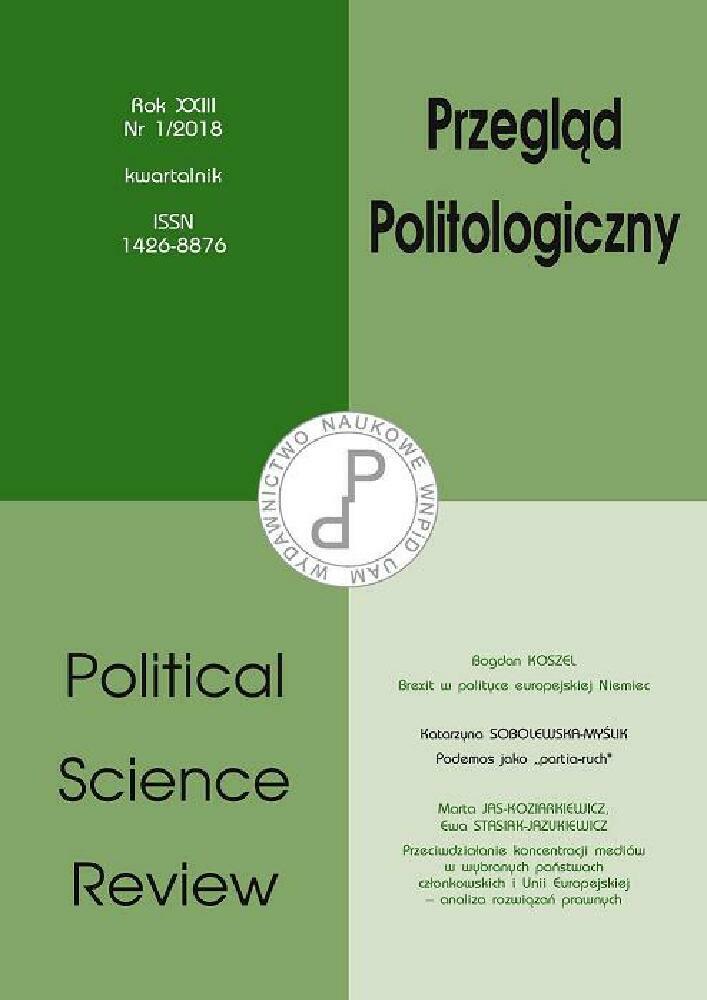Abstrakt
After a period of relatively small activity in this region, in 2007, the European Union offered a strategy for Central Asia. This strategy addressed many issues, including democratic deficit and human rights violations. The main obstacles to the implementation of the strategy are autocratic tendencies and corruption, the influence of neighbors strongly leaning towards autocracy and the post-Soviet legacy. Additionally, the EU’s activity is overshadowed by the US and has minimal capacity for pursuing its own policy toward Central Asia. Another problem is the fact that after implementing this EU strategy toward Central Asia there are no new initiatives which contribute to more visible European activity in that region.
Bibliografia
Axyonova V. (2012), EU Human Rights and Democratisation Assistance to Central Asia: In Need of Further Reform, 10.09.2017.
Bodio T., Załęski P. (2008), Problemy budowy społeczeństwa obywatelskiego w państwach Azji Centralnej, in: Region Azji Centralnej jako obszar wpływów międzynarodowych, pod red. B. Bojarczyka, A. Ziętek, Lublin.
Central Asia – Education and research, http://ec.europa.eu/europeaid/regions/central-asia/eu-supporteducation-and-research-cooperation-central-asia_en, 20.10.2017.
Crawford G. (2008), EU human rights and democracy promotion in Central Asia: From Lofty principles to Lowly self-interests, “Perspectives on European Politics & Society”, 9, 2, pp. 172–191.
Davis P., Dombrowski P. (2000), International Assistance to the Former Soviet Union: Conditions and Transitions, “Policy Studies Journal”, no. 28(1).
Decyzja Rady (WPZiB) 2016/596 z dnia 18 kwietnia 2016 r. przedłużająca mandat Specjalnego Przedstawiciela Unii Europejskiej w Azji Środkowej.
Delcour L. (2011), Shaping the Post-Soviet Space? EU Policies and Approaches to Region-Building, Burlington.
Emerson M., Boonstra J. (2010), Into Euroasia: Monitoring the EU’s Central Asia Strategy, Brussels: Centre for European Policy Studies (CEPS), Madrid.
Europejski Trybunał Obrachunkowy, https://europa.eu/european-union/about-eu/institutions-bodies/european-court-auditors_pl, 20.10.2017.
Gacek Ł. (2013), Azja Centralna w polityce energetycznej Chin, Wydawnictwo Uniwersytetu Jagiellońskiego, Kraków.
Hartman J. W. (2016), The May 2005 Andijan Uprising: What We Know, Central Asia-Caucasus Institute & Silk Road Studies Program – A Joint Transatlantic Research and Policy Center, “Silk Road Paper.”
Hoffman K. (2010), The EU in Central Asia: Successful Good Governance Promotion?, “The World Quarterly”, no. 31(1).
Kozłowski K. (2012), Kolory Rewolucji, Poltext, Warszawa.
Kreutz J. (2005), Hard Measures by a Soft Power? Sanctions Policy of the European Union, “Policy Paper”, no. 45, Bonn International Center for Conversion.
Lang J. (2013), The radical Islamic militants of Central Asia, New York.
Matveeva A. (2006), EU Stakes in Central Asia, “Chaillot Papers”, no. 91, July, special issue.
McGlinchey E., Project M. (2011), Chaos, Violence, Dynasty: Politics and Islam in Central Asia, University of Pittsburgh Press, Pittsburgh.
Micklin P. (2007), The Aral Sea Disaster, “Annual Review of Earth and Planetary Sciences”, vol. 35, http://www.terras-altas.net.br/MA-2013/desastres%20ambientais/AralSeaDisaster.pdf, 18.05.2017.
Olcott M. B. (2012), In the Whirlwind of Jihad, Brookings Institution Press, Washington, DC.
PCA-Kazakhstan, (1996), http://ec.europa.eu/external_relations/central_asia/pca/index_en.htm, 10.06.2017.
Perkowska A. (2013), Dezintegracja regionu Azji Centralnej jako pochodna uwarunkowań wewnętrznych, “Polityka i Bezpieczeństwo”, no. 2.
Pomoc Rozwojowa dla UE dla Azji Środkowej (2013), Europejski Trybunał Obrachunkowy. Sprawozdanie Specjalne no. 13.
Rashid A. (1997), The New Great Game – the Battle for Central Asia’s Oil, “Far Eastern Economic Review”, 10 April.
Rashid A. (2003), Dżihad. Narodziny wojującego islamu w Azji Środkowej, Warszawa.
Rocznik Strategiczny 2014/15 (2015), Przegląd sytuacji politycznej, gospodarczej i wojskowej w środowisku międzynarodowym Polski, t. 20, Warszawa.
Sikorski T. (2010), Masakry etniczne w Kirgistanie przyczyny oraz reakcje międzynarodowe, “Biuletyn” Polskiego Instytutu Stosunków Międzynarodowych, no. 98, Warszawa, http://www.pism.pl/zalaczniki/Biuletyn_706.pdf, 15.05.2017.
Słojewska A., Wielkie bitwy o wodę, http://www.rp.pl/artykul/1035598-Wielkie-bitwy-o-wode.html#ap-2, 17.05.2017.
Stein M. (2012), Uzbekistan’s View of Security in Afghanistan After 2014, “Military Review”, vol. 92, issue 3.
The European Union and Central Asia: The New Partnership in action (2009); http://eeas.europa.eu/central_asia/docs/2010_strategy_eu_centralasia_en.pdf, 10.10.2017.
Transparency International (2016), http://www.transparency.org/country#TKM. Voloshin G. (2014), The European Union’s Normative Power in Central Asia: Promoting Values and Defending Interests, New York.
Wiśniewska I. (2013), Integracja euroazjatycka – rosyjska próba ekonomicznego scalenia obszaru poradzieckiego, “Prace OSW” nr 44, Warszawa.
World Drug Report (2013), United Nations on Drugs and Crime, Vienna.
